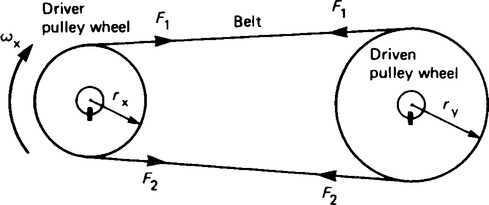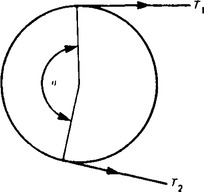Torque
Publisher Summary
This chapter provides an overview on torque. When two equal forces act on a body they cause the body to rotate, and the system of forces is called a couple. The turning moment of a couple is called a torque, T. Torque is a gauge that measures how much force is acting on an object that causes it to rotate. The unit of torque is the Newton meter, Nm. A common and simple method of transmitting power from one shaft to another is by means of a belt passing over pulley wheels that are keyed to the shafts. Typical applications include an electric motor driving a line of shafting and an engine driving a rotating saw.
1. When two equal forces act on a body as shown in Figure 38.1, they cause the body to rotate, and the system of forces is called a couple.

2. The turning moment of a couple is called a torque, T. In Figure 38.1, torque = magnitude of either force × perpendicular distance between the forces, i.e.
The unit of torque is the newton metre, Nm.
3. When a force F newtons is applied at a radius r metres from the axis of, say, a nut to be turned by a spanner, the torque T applied to the nut is given by:
4. Figure 38.2(a) shows a pulley wheel of radius r metres attached to a shaft and a force F newtons applied to the rim at point P. Figure 38.2(b) shows the pulley wheel having turned through an angle θ radians as a result of the force F being applied.

The force moves through a distance s, where arc length s = rθ.
Angular velocity, ω = 2πn rad/s, where n is the speed in rev/s.
Hence, power, P = 2πn T watts.
Thus the torque developed by a motor whose spindle is rotating at 1000 rev/min and developing a power of 2.50 kW is given by:

6. From para. 4, work done = Tθ, and if this work is available to increase the kinetic energy of a rotating body of moment of inertia I, then
where ω1 and ω2 are the initial and final angular velocities,

where t is the time and (ω2 − ω1) is the change in angular velocity, i.e. αt, where α is the angular acceleration.
Thus if a shaft system has a moment of inertia of 37.5 kg m2, the torque required to give it an angular acceleration of 5.0 rad/s2 is given in:
Power transmission by belt drives
(i) A common, and simple method of transmitting power from one shaft to another is by means of a belt passing over pulley wheels which are keyed to the shafts, as shown in Figure 38.3. Typical applications include an electric motor driving a line of shafting and an engine driving a rotating saw.

(ii) For a belt to transmit power between two pulleys there must be a difference in tensions in the belt on either side of the driving and driven pulleys. For the direction of rotation shown in Figure 38.3, F2 > F1.
The torque T available at the driving wheel to do work is given by:
and the available power P is given by:
(iii) From para. 12(i), page 291, the linear velocity of a point on the driver wheel, vx = rxωx. Similarly, the linear velocity of a point on the driven wheel, vy = ryωy.

For example, a 15 kW motor is driving a shaft at 1150 rev/min by means of pulley wheels and a belt. The tensions in the belt on each side of the driver pulley are 400 N and 50 N and the diameters of the driver and driven pulley wheel are 500 mm and 750 mm respectively. The power output from the motor is given by:


The speed of the driven pulley is obtained from
i.e. speed of driven pulley wheel,
(i) The ratio of the tensions for a flat belt when the belt is on the point of slipping is
µ is the coefficient of friction between belt and pulley,
θ is the angle of lap, in radians (see Figure 38.4), and

(ii) For a vee belt as in Figure 38.5, the ratio is

where α is the half angle of the groove and of the belt.
This gives a much larger ratio than for the flat belt. The V-belt is jammed into its groove and is less likely to slip. Referring to Figure 38.5, the force of fraction on each side is µRN where RN is the normal (perpendicular) reaction on each side. The triangle of forces shows that ![]() where R is the resultant reaction.
where R is the resultant reaction.
The force of friction giving rise to the difference between T1 and T2 is therefore
The corresponding force of friction for a flat belt is µR. Comparing the forces of friction for flat and V-belts it can be said that the V-belt is equivalent to a flat belt with a coefficient of friction given by µ/ (sin α).

